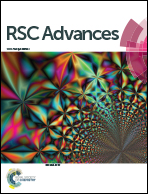The origin of Mo promotion during H2 pretreatment on an Fe catalyst for Fischer–Tropsch synthesis†
Abstract
It is of vital importance but remains a grand challenge to understand comprehensively the effect of promoter elements on the active sites. Here, we report the experimental evidence of the origin of the promotion of molybdenum (Mo) during H2 pretreatment on iron (Fe) catalysts for Fischer–Tropsch synthesis (FTS). By combing in situ laser Raman spectroscopy, Mössbauer spectroscopy, electron microscopy and in situ infrared spectroscopy, the promotion is related to the dispersion of Mo on the Fe surface during H2 pretreatment, which inhibits the agglomeration of Fe and favors the formation of small Fe nanoparticles (NPs). The Mo coverage showed a strong dependency on the pretreatment temperature and the Mo amount in the FeMo catalyst. The strong Fe–Mo interaction caused by the Mo coverage weakened the activation of CO molecules on active Fe sites, which primarily accounts for the decline in the intrinsic activity (TOFCO) of active Fe sites.



 Please wait while we load your content...
Please wait while we load your content...